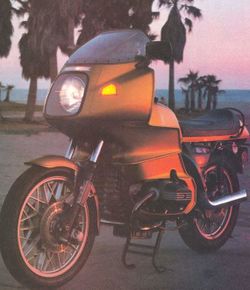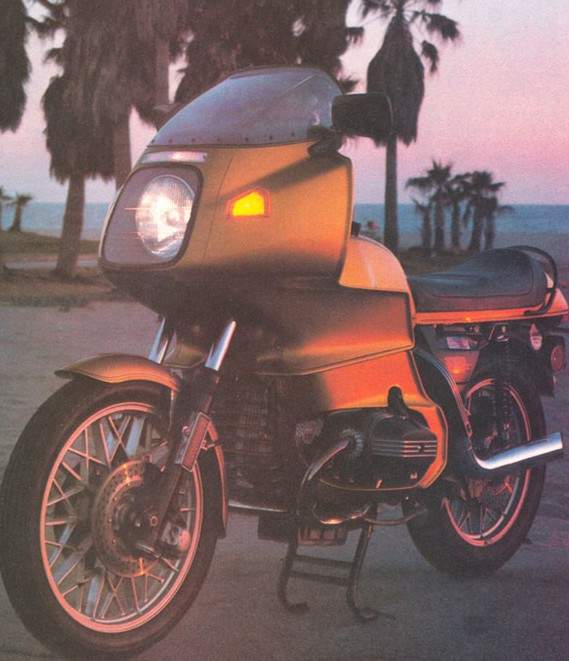BMW R100RS Turbo
 |
|
| BMW R100RS Turbo | |
| Manufacturer | |
|---|---|
| Weight | |
| Manuals | Service Manual |
Photos[edit | edit source]
Overview[edit | edit source]
BMW R 100RS Turbo
Cycle Guide 1978
You may have been puzzled in recent months as to
why motorcycles which already go' faster than anything else on wheels have
received large amounts of new horsepower by way of the hysterical magic of
turbocharging. Well, there certainly may be no rational reasons, but there are a
whole host of perfectly sound irrational reasons, beginning with the most
obvious: Fast, in America, is never fast enough. Hence fearsome turbo-monsterbikes
ripping off eleven- and even ten-second quarter-miles. And hence, naturally, the
inevitable spread of the turbo's appeal, which now extends even into the upright
ranks of BMW owners.
Admittedly, nursing secret desires for
blitzwagens is hardly what one would expect of Beemer operators, but the fact
is, according to Lou Nauert, Vice President for Research and Development at
American Turbo-Pak, that's just exactly the way it is. Ever since a spy photo of
a BMW mit turbolader appeared in a national magazine, Nauert says that BMW owner
interest
has amazed him; people have ridden, he says,
thousands of miles just to have a look at the technology that could turn their
civilized and finely refined motorcycles into ravening beasts. So Nauert and
American Turbo-Pak have happily pursued turbocharging for the German
opposed-twins, and you see the result here: a brilliantly painted (Gotterdamerung
Gold?) BMW R 100RS with ATP turbo kit, the prototype for what Nauert hopes will
be a long line of Beemer turbos.
Considering American Turbo-Pak's standing in the
infant aftermarket turbo industry, his hopes just might materialize. ATP, you
will recall, was chosen by ex-Kawasaki marketing maven Alan Masek to be the
prime contractor for the ferocious Z-1R TC. And, of course, ATP's own drag
racer, Pee Wee Gleason, has been spreading the turbo gospel himself at drag
strips all over the country. So if anyone is likely to make a turbo-Beemer fly,
it will probably be Lou Nauert and ATP.
There are, of course, both philosophical and
engineering questions to be answered about the whole idea of an aftermarket
bolt-on turbo kit for something like the BMW R 100RS. BMW, after all, has made
its position known simply by producing the bike and then asking over $6000 for
it; as it stands, it must represent what BMW thinks a fast road bike should be.
And doubtless many owners and marque-lovers feel the same way. But then there's
the nagging question of sheer speed; an R 100RS is no match in a straightout
drag race with a Kawasaki KZ1000, Yamaha XS11 or Suzuki GS1000and that has to
rankle Beemer owners, especially those who paid over six grand for their bikes.
So another $1095 for a turbo kit (the price includes the turbo, all plumbing, a
boost gauge, a mount to relocate the clock, a fuel pump and a deeper sump with
one more quart capacity), to erase the irritating itch raised by being blown off
in stoplight races could well seem a worthwhile investment. And not to be
overlooked is the air of exclusive sophistication a turbocharger brings to any
machine. Would it be too much to suppose that a BMW R 100RS owner with a turbo
kit would think of his bike the way a Turbo Porsche owner thinks of his megabuck
car? Probably not.
The engineering problems, as opposed to the
philosophical implications of turbocharging a BMW flat twin, were quite another
matter; Nauert and American Turbo-Pak didn't have to suppose that getting a
satisfactory product would take more than simply bending up some new tubes and
bolting on a standard Rajay turbine, they knew it. Early experiments seemed to
confirm the conventional view that a turbo would be a waste of time on a BMW,
but ATP persevered in the traditional cottage-industry fashionpainstaking trial
and error. Nauert says that his first inclinationto lower the compression ratio
substantiallyproduced an engine that ran well, but with no particular increase
in horsepower. Huddling with Butler & Smith (the North American importers of BMW
motorcycles) led to raising the compression ratio back to standard levels. And
that change, along with the others implemented throughout three test units and
unknown man-hours, resulted in the final kit now offered for sale.
The kit itself is fundamentally different from
that for the four-cylinder Japanese bikes. The Rajay turbine, the heart of the
unit, is entirely changed. Whereas the Z-1R TC uses a model 370 F40, the R90 and
R100 series (all 900- and 1000-cc bikes) demand the more-efficient and smaller
377 F25. This lighter turbine spins with what Nauert figures to be a 50-percent
increase in oil delivered to the impeller shaft. And the turbine fan itself is
only 88-percent the diameter of the big Kawasaki's. These differences are
mandated by the way the exhaust pulses reach the turbine; in the Kawasaki, with
four cylinders, a steadier flow spins the turbo than in the two-cylinder BMW.
And since a turbo has to turn very high rpm to be effective, a smaller turbine
was required.
The changes necessary to the standard R100RS (or
any R100) are substantial enough to warrant more than afternoon shade-tree skill
levels in assembly. First, there's the location and installation of the turbo
unit, the battery (a thinner one must be used on the Turbo) and fuel pumpan
operation which demands that the battery box be opened up in front to
accommodate the turbo housing. Then there's the plumbing, which on the BMW is
fairly complex. (We counted 12 welds in the system.) Tolerance for error is
slight; the waste gate, for instance, is sandwiched between the left rear frame
tube and the transmission casea position that allows access for twisting the
boost screw but isn't designed for sloppy installation.
The boost gauge (which displays vacuum in
lbs/in.2 increments) is also different than the glycerin-filled gauge mounted on
the Z-1R TC handlebar clamp. The "dashboard" of the R 100RS happens to provide
just the right size hole for a VDO undamped gauge. This tidy gauge displaces the
clock into an ATP-supplied and BMW-made nacelle which fits neatly below the
handlebars.
American Turbo-Pak says that those are the only
modifications necessary to the bike to get it running on turbo power. But Nauert
has gone further on his bike. He's installed another clutch disc (with alternate
pressure fingers removed) and has discarded the standard BMW remote-linkage
shifter in favor of an old lever simply hung directly on the shifter shaft. The
clutch pull is thereby dramatically increasedit would substitute for a
bodybuilding machine any dayand the direct shifting requires a healthy and
positive toe movement to select the gears.
Nauert says that at street boosteight to ten
poundsmodifications to the drive train, valve gear or pistons aren't required.
But then he adds the classic caveat: Nothing is free, not even the magic power
from a turbo. So any "hard" usage will undoubtedly cause much faster wear and
tear than normal.
But what happens when you screw it to the stop
and revel in a little "hard" use? A good deal. ATP claims that with Pee Wee
Gleason aboard on a cool day at Orange County Dragstrip, the gold R 100RS you
see here has turned a best ET of 11.65 seconds at 118 mph. Our experience, on
another calm, cool day at Orange County, was slightly different, but still
indicative of the new horsepower found in the Beemer. Our best run was 12.6
seconds at 112 mph, running at 15 pounds boost without the simple baffle in the
baloney-sliced exhaust pipe. The same day, a lot of tweaking and Pee Wee himself
only managed a 12.39 at 105, so it seems as though our times were pretty
representative.
Staying within the realm of pure numbers for a
moment, that figure of 12.6 seconds needs to be put into perspective. Granted,
most testers have managed to squeak out mid-to-low 12-second times for all the
standard Japanese 1000-cc fours, and even some 11-second times. But that same
12.6 represents almost an entire second (0.8 seconds, to be exact) lopped off
the previous standard R R100RS's timewith the same rider doing the testing at
the same race track.
Moreover, the real benefit of a turbo to the
street rider isn't really in banzai drag runs, anyway. It's in mid- and
high-speed acceleration while rollinga concept fully realized in the behavior
of the turbocharged R100RS.
In everyday use, the Turbo RS works just like the
standard bike; no funny habits, and none of the jerkiness and nervousness at the
throttle associated with some of the four-cylinder applications. The bike even
sounds much the same. Cold starts are a snap; a few pumps of the throttle and it
lights off without a hitch.
Running moderate (circa eight pounds) boost on
the road gives the R100RS no more appreciable increase in the feel of its power
delivery until about 4500-5000 rpmand Nauert readily admits that getting the
turbo to work below the first test unit's disappointing 6000 rpm was a major
challenge. The smaller, more efficient turbine is, in fact, all that made a
usable power band possible.
And it is usable. The famous tractability of the
big Beemer seems complemented by the turbo, not destroyed by it. The same
effortless mid-range power is on tap, but with the turbo, when the 'mixture is
right and the boost properly set, the last 2500 rpm in each gear goes by in a
satisfyingly lusty rush. You learn, on the Turbo RS, not to stir the gear lever
like a frantic two-stroke's or even a four-cylinder four-stroke's; you come upon
obstacles on the road with an easily-developed sense of timing for the final
high-speed rush, the passing blitz. And when it comes, there isn't that awesome
weight on your chest and fearsome lunge typical of the Z-1R TC, there's simply a
slight impression of compressed time. Oddly enough, even considering the (to us)
out-of-character cosmetics of the baloney-slice muffler, the awkWardly placed
air filter (which sits near your right knee) and the bizarre exhaust plumbing,
such a sensation seems right at home with the BMW.
The question is, of course, can those kinds of
sensations and a little more speed be worth over a grand? And the answer is
predictable: It depends. Not just on your view of the trade-offs involved
(slightly lower fuel economy, an instantly voided warranty and unknown
durability problems), but on how fast you want to go and how you want to go
fast. Both are questions central to each enthusiast's personal involvement with
the sport, and neither is entirely answerable here.
Lou Nauert and American Turbo-Pak, on the other
hand, have no such problems. They have seen their future, and as far as they're
concerned, the whole thing is turbocharged.
Source Cycle Guide 1978
